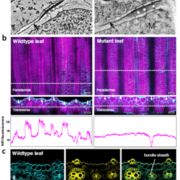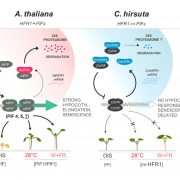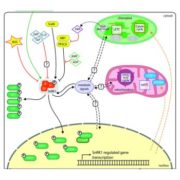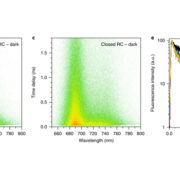Etioplasts: The Role of Digalactosyldiacylglycerol
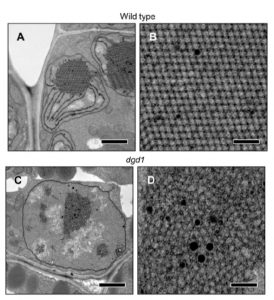 In dark-grown plants, the plastids of cotyledon cells develop as etioplasts. Etioplasts contain unique internal lattice membrane structures called prolamellar bodies (PLBs) and lamellar prothylakoids (PTs). PLBs accumulate protochlorophyllide (Pchlide), a chlorophyll intermediate, in a complex with NADPH and an enzyme called light-dependent NADPH:Pchlide oxidoreductase (LPOR). Two galactolipids, namely monogalactosyldiacylglycerol (MGDG) and digalactosyldiacylglycerol (DGDG), are major constituents of etioplast membranes. The role of MGDG has already been elucidated: it facilitates the synthesis of Pchlide and the formation of the Pchlide-LPOR-NADPH complex in etioplasts. The role of DGDG in etioplasts, however, is less clear, and this led Fujii et al. (10.1104/pp.18.00227) to characterize an Arabidopsis knockout mutant (dgd1). DGD1 encodes the major isoform of DGDG synthase in developing etioplasts. The DGDG content of etiolated dgd1 seedling was 20% that found in wild-type, the lattice structure of the PLBs was disordered and the development of PTs impaired. Moreover, the formation of the Pchlide-LPOR-NADPH complex and the dissociation of this complex after photoconversion of Pchlide to chlorophyllide were both impaired in dgd1. Total carotenoid content also decreased in etiolated dgd1 seedlings, but the carotenoid composition was unchanged. These findings suggest that DGDG plays a role in the formation of the internal membrane structures in etioplasts as well as membrane-associated processes.
In dark-grown plants, the plastids of cotyledon cells develop as etioplasts. Etioplasts contain unique internal lattice membrane structures called prolamellar bodies (PLBs) and lamellar prothylakoids (PTs). PLBs accumulate protochlorophyllide (Pchlide), a chlorophyll intermediate, in a complex with NADPH and an enzyme called light-dependent NADPH:Pchlide oxidoreductase (LPOR). Two galactolipids, namely monogalactosyldiacylglycerol (MGDG) and digalactosyldiacylglycerol (DGDG), are major constituents of etioplast membranes. The role of MGDG has already been elucidated: it facilitates the synthesis of Pchlide and the formation of the Pchlide-LPOR-NADPH complex in etioplasts. The role of DGDG in etioplasts, however, is less clear, and this led Fujii et al. (10.1104/pp.18.00227) to characterize an Arabidopsis knockout mutant (dgd1). DGD1 encodes the major isoform of DGDG synthase in developing etioplasts. The DGDG content of etiolated dgd1 seedling was 20% that found in wild-type, the lattice structure of the PLBs was disordered and the development of PTs impaired. Moreover, the formation of the Pchlide-LPOR-NADPH complex and the dissociation of this complex after photoconversion of Pchlide to chlorophyllide were both impaired in dgd1. Total carotenoid content also decreased in etiolated dgd1 seedlings, but the carotenoid composition was unchanged. These findings suggest that DGDG plays a role in the formation of the internal membrane structures in etioplasts as well as membrane-associated processes.


